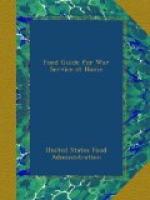THE PART OF THE UNITED STATES
As with wheat, meat for Europe must come chiefly from the United States and Canada, since ships are few and the Atlantic the shortest route. The extra demand upon us is to offset the loss from inaccessible markets and the depleted herds in Europe. The United States is now exporting far larger quantities than it has ever exported before. In March, 1918, we sent over 87,000,000 pounds of beef. Ordinarily we export between 1,000,000 and 2,000,000 pounds a month. Of pork we sent 308,000,000 pounds—six times more than usual. It is roughly estimated that it is necessary to send 75,000,000 pounds of meat and meat products of all kinds abroad weekly to the Allies and our army.
To buy and sell this huge and unusual quantity of meat, a careful organization has been necessary. At first the Allied nations bought meat in this country as best they could in competition with the domestic market and each other, often feverishly to meet emergencies. LAST DECEMBER A COMMISSION WAS FORMED TO BUY FOR ALL THE ALLIES. The prices to be paid are settled by experts, after careful study, so that packers, storage warehouses, and producers shall all have adequate, but not excessive return for their labor. The buying is planned ahead so that we can ship at times when we have plenty.
The meat which we are shipping now is coming in part from an increased slaughter of cattle and hogs, a condition which may have serious consequences in reducing our reserve. The need for conservation is constant, though at times the situation becomes easier in one kind of meat or another. In the summer of 1917 we were short on hogs. In the spring of 1918, thanks to the “keep-a-pig” movement and vigorous conservation, as well as high prices, we temporarily had hogs in plenty. Beef is short for the summer season. Policies must change frequently with fluctuating supplies and varying demands from Europe. However, the export demand for our forces and the Allies is limited only by shipping capacity, and it may be that we shall have a still larger demand at the war’s end which will tax any reserve which we can possibly accumulate.
MEAT CONSERVATION
Meat does not play nearly so important a part in the world’s dietary as we are accustomed to think. There is no comparison, in the quantity consumed, between meat and bread, or even meat and sugar or potatoes. Half of the people of the earth eat little or none of it. Only in two kinds of communities is meat used largely—new and thinly populated countries with much grazing-land, or wealthy industrial countries.
Australia and New Zealand are of the first type, consuming more meat per person than any other country in the world—5 pounds a week in Australia and 4 pounds in New Zealand. The United States, parts of which may be considered in both classes, eats about 31/4 pounds per person weekly. This is much less than some years ago, when there was more grazing-land.




